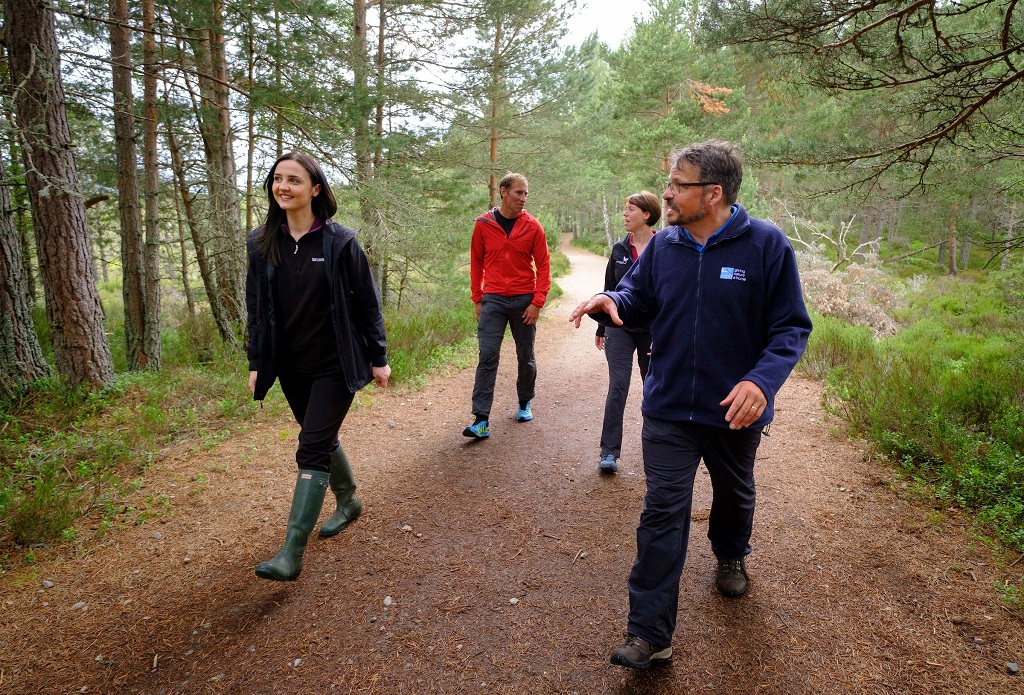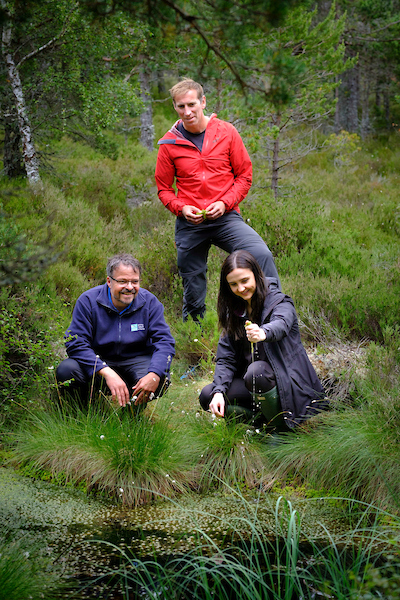
Johnnie Walker joins RSPB Scotland to save peatland
Johnnie Walker Scotch whisky has joined forces with RSPB Scotland to help save a crucial area of peatland in one of Scotland’s national parks.
The plans were announced during a visit by Mairi McAllan, Minister for Environment, Biodiversity and Land Reform in the Scottish Government, who has responsibility for peatlands, to RSPB Scotland’s Abernethy Nature Reserve in the Cairngorm National Park.
Despite covering only 3% of the world’s surface, peatlands store 30% of the world’s carbon and are vital to the health and wellbeing of the whole planet. The UK has around three million hectares of peatland – the vast majority of which are in Scotland. Healthy peatbogs, kept in good condition and retaining water, on average sequester about four times more CO2 than the equivalent area of forest.
The vast An Lurg North peatland area, which is part of the Abernethy Reserve high in the Cairngorm plateau, is severely degraded among some of the highest priority areas for peatland restoration in Scotland.
Now with investment from Johnnie Walker, vital work will be carried out to continue the restoration and conservation of the peatland for future generations of wildlife and the local community. The An Lurg area had already undergone a series of preparatory works supported by Peatland ACTION, a NatureScot partnership initiative funded by Scottish Government, and is part of a priority habitat within the Cairngorms Connect project.
The support from Johnnie Walker will focus on restoration work on 88 hectares, which will result in a total area of 160 hectares of the Cairngorm plateau being conserved – the equivalent of around 224 football pitches.
Ewan Andrew, chief sustainability officer for Johnnie Walker’s parent company Diageo, said: ‘We are really excited to be setting out on this journey with RSPB Scotland to help restore this crucial piece of Scotland’s natural environment.

Mairi McAllan (Minister for Environment, Biodiversity & Land Reform) is shown the work that is currently ongoing
‘This project is not just about saving and preserving peatland, it is about helping tackle climate change and about making a positive impact on the biodiversity this beautiful landscape provides for wildlife. The area is also part of the water catchment for the River Spey, the greatest whisky river in the world, and preserving the peatland will enhance and protect water quality in the future.’
Uwe Stoneman, senior site manager at RSPB Scotland Abernethy, said: ‘It’s fantastic to have this support from Johnnie Walker to continue the vital restoration work on the An Lurg peatland. Healthy peatlands are vital in tackling the nature and climate emergency. The benefits of the work being done at An Lurg help not only the species that rely on this habitat but also filter through a far wider area of the Cairngorms landscape.’
Environment Minister Mairi McAllan was briefed on the plans for the peatland restoration and its impact on the local environment during a visit to the RSPB Scotland Abernethy reserve.
She said: ‘Restoring peatlands is a central part of our response to the twin crises of climate change and biodiversity loss in Scotland. Peatlands are an integral part of our cultural and natural heritage and it’s great to see RSPB and Johnnie Walker working together to protect them. We hope this partnership encourages further private investment in peatland restoration and Scotland’s natural capital to support biodiversity, create green job opportunities and help deliver our world leading emission reduction targets.’
RSPB Scotland Abernethy Nature Reserve is part of Cairngorms Connect, the UK’s biggest habitat restoration project. Cairngorms Connect is a partnership of neighbouring land managers, committed to a bold and ambitious 200-year vision to enhance habitats, species and ecological processes across a vast area within the Cairngorms National Park
Steve Blow, delivery manager at Cairngorms Connect, said: “Peatland restoration is one of the landscape scale habitat restoration objectives shared by all of the Cairngorms Connect Partners (RSPB, Wildland, FLS and NatureScot). Both on the plateau and down in the forests, these bogs support endangered wildlife, lock up carbon from the atmosphere and can help reduce flooding, so are an invaluable resource.’

Uwe Stoneman (front, left), Mairi McAllan and Ewan Andrew (Chief Sustainability at Diageo)
Peatlands are not only home to a whole host of rare and unusual wildlife, but they are also the world’s largest terrestrial carbon store. In the UK, peatlands store more carbon than all our forests combined.
This habitat is found across the Cairngorms National Park – particularly on the higher ground where blanket bogs form. However, much of the Cairngorms’ peatlands are in a heavily degraded condition, causing the loss of carbon and threatening the species that rely on them. Among other rare species, the landscape supports the sundew plant – one of the UK’s only carnivorous plants – and hen harriers.
The crucial restoration work at An Lurg will begin later this summer with a target completion of autumn 2021, and will see features such as coir logs (fibre logs used to stabilise banks) and dams to slow the speed of water flow and stimulate the development of vegetation in key areas will be installed.
The An Lurg site forms part of the water basin of the river Spey, which provides the water for some of Scotland’s best-known and loved distilleries on the rivers’ banks, including Cardhu Distillery, which is the Speyside Home of Johnnie Walker. Restoring biodiversity upstream is expected to improve water quality downstream. The partnership between Diageo and RSPB Scotland will monitor water samples throughout the project to assess its impact.
In 2020, Diageo launched its Society 2030: Spirit of Progress strategy which champions diversity, inclusion and pioneers grain-to-glass sustainability. The plan committed the business to relying on 100% renewable energy, achieving carbon neutrality, having 100% recycled or recyclable packaging, and use 30% less water to create its spirits.
For more information on the Diageo Society 2030: Spirit of Progress visit HERE and for more information on the Johnnie Walker Next Step sustainability plans visit HERE.
TAGS

